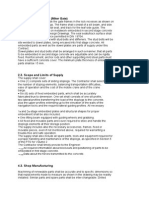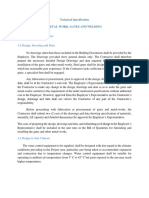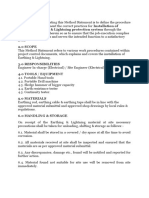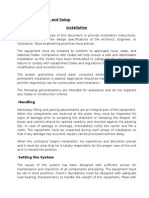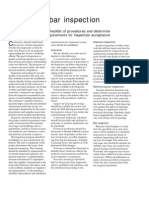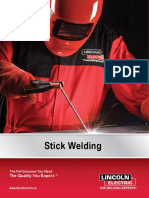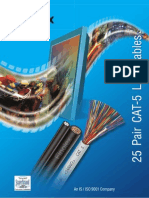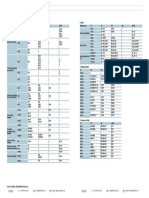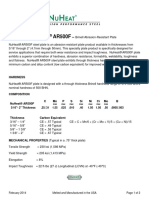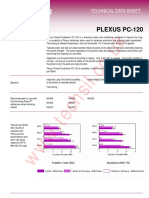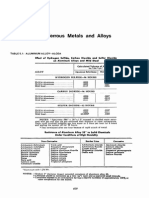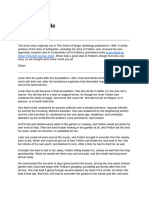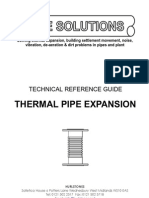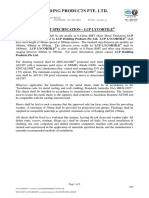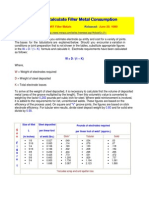GBSP 18
GBSP 18
Uploaded by
Mohammad Ibna AnwarCopyright:
Available Formats
GBSP 18
GBSP 18
Uploaded by
Mohammad Ibna AnwarOriginal Title
Copyright
Available Formats
Share this document
Did you find this document useful?
Is this content inappropriate?
Copyright:
Available Formats
GBSP 18
GBSP 18
Uploaded by
Mohammad Ibna AnwarCopyright:
Available Formats
MODULAR EXPANSION JOINT Effective: May 19, 1994 Revised: January 1, 2007 Description.
This work shall consist of furnishing and installing a modular expansion joint(s) as shown on the plans, and according to applicable portions of the Standard Specifications. General. The expansion joint device shall be capable of handling the specified longitudinal movement. In addition, when specified, the joint shall also be capable of handling the differential non-parallel longitudinal movement. The expansion joint device shall effectively seal the joint opening in the deck surface and barrier curbs against the entrance of water and foreign materials. There shall be no appreciable change in the deck surface plane with the expansion and contraction movements of the bridge. The device shall consist of a shop-fabricated modular assembly of transverse neoprene seals, edge and separation beams, bearing on support bars spanning the joint opening. The assembly shall maintain equal distances between intermediate support rails, at any cross section, for the entire length of the joint. The assembly shall be stable under all conditions of expansion and contraction, using a system of longitudinal control springs and upper and lower support beam bearings and springs. At sidewalks, concrete median barriers and concrete parapet joints, a sliding steel plate shall be fabricated and installed according to the plans. Painting or galvanizing of sliding steel plates shall be as specified on the plans. The expansion joint system options shall be limited to the following pre-approved systems: For Modular Expansion Joints: Steelflex system, by the D.S. Brown Company WABO system, by the Watson Bowman Acme Corporation LG System, by TechStar Incorporated. For Swivel Modular Expansion Joints: MAURER Swivel system, by the D.S. Brown Company WABO X-CEL system, by the Watson Bowman Acme Corporation. Pre-approval of the expansion joint system does not include material acceptance at the jobsite. Submittals: Shop drawings and a copy of the calculations and support documents shall be submitted to the Engineer for approval according to Article 105.04 of the Standard Specifications. Submittals will be required for each modular expansion joint device specified. In addition the Contractor shall provide the Department with a certification of compliance by the manufacturer listing all materials in the system. The certification shall attest that the system conforms to the design and material requirements and be supported by a copy of the successful results of the fatigue tests performed on the system as herein specified. Submittals with insufficient test data and supporting certifications will be rejected.
The shop drawings shall include tables showing the total anticipated movements for each joint and the required setting width of the joint assemblies at various temperatures. Design Requirements: The maximum vertical, transverse and horizontal rotations and displacements shall be defined and included in the design. The expansion joint device(s) shall be designed, detailed and successfully tested, for non AASHTO LRFD designed structures, according to the requirements specified in NCHRP Report 402 Fatigue Design of Modular Bridge Expansion Joints and NCHRP Report 467 Performance Testing for Modular Bridge Joint Systems and for LRFD designed structures according Section 14 of the AASHTO LRFD Bridge Design Specifications. Top, bottom and sides of support bars shall be restrained to prevent uplift, transmit bearing loads, and maintain the lateral position of the bars. The total movement of each individual sealing element shall not exceed 3 in. (75 mm). Materials: (a) Metals. The hot-rolled or extruded steel sections and the support bars shall meet the material requirements specified by the manufacturer. Stainless steel sheets for the sliding surfaces of the support bars shall conform to the requirements of ASTM A240 (A240M) type 302 or 304. The use of aluminum components in the modular joint will not be allowed. (b) Preformed Elastomeric Seals. The elastomeric sealing element shall be either an elastomeric compression seal meeting the requirements of AASHTO M 220 or strip seal meeting the requirements of Article 1052.02(a) of the Standard Specifications. Lubricant/Adhesive for installing the preformed elastomeric elements in place shall be a one-part, moisture-curing, polyurethane and hydrocarbon solvent mixture as recommended by the manufacturer and containing not less than 65 percent solids. (c) Support Bar Bearings. Support bar bearings shall be fabricated from elastomeric pads with polytetrafluorethylene (PTFE) surfacing or from polyurethane compound with PTFE sliding surfaces. The elastomeric and PTFE materials shall meet the requirements of Section 1083 of the Standard Specifications. (d) Control Springs. Suitable elastomeric type springs which work longitudinally shall be used to maintain the equidistant spacing between transverse edge and separation beams when measured at any given cross section through the joint.
(e) Support Bars. Support bars shall incorporate stainless steel sliding surfaces to permit joint movement. Construction Requirements General. Installation of expansion devices shall be according to the plans and shop drawings. The fabricator of the modular joint assembly shall be AISC certified according to Article 106.08(a) of the Standard Specifications. In lieu of AISC certification, the Contractor may have all welding on main members (support bars and separation beams) observed and inspected by independent (third party) personnel at the Contractors expense. Welding shall then be observed by a Certified Welding Inspector (CWI) in addition to the manufacturer's own welding inspection. Third party Non Destructive Examination (NDE) shall be performed by inspector(s), certified as level II in applicable methods, and all complete penetration beam-to-bar welds and butt joints in beams shall be UT inspected and 10 percent of fillets and partial pen welds shall be MT inspected. The manufacturer of the expansion device shall provide a qualified technical service representative to supervise installation. Modular expansion joint devices shall be factory prefabricated assemblies, preset by the manufacturer prior to shipment with provisions for field adjustment for the ambient temperature at the time of installation. Unless otherwise shown on the plans, the neoprene seals shall be continuous without any field splices. All steel surfaces of the prefabricated assembly shall be shop painted with the primer specified for structural steel, except areas in direct contact with the seals, galvanized items and stainless steel surfaces. The metal surfaces in direct contact with the neoprene seals shall be blast cleaned to permit a high strength bond of the lubricant/adhesive between the neoprene seal and mating metal surfaces. The prefabricated joint assembly shall be properly positioned and attached to the structure according to the manufacturers approved shop drawings. The attachment shall be sufficiently rigid to prevent non-thermal rotation, distortion, or misalignment of the joint system relative to the deck prior to casting the concrete. The joints shall be adjusted to the proper opening based on the ambient temperature at the time of installation and then all restraints preventing thermal movement shall be immediately released and/or removed. The joint assembly units shall be straight, parallel and in proper vertical alignment or reworked until proper adjustment is obtained prior to casting of the concrete around the joint. After the joint system is installed, the joint area shall be flooded with water and inspected, from below for leakage. If leakage is observed, the joint system shall be repaired, at the expense of the Contractor, as recommended by the manufacturer and approved by the Engineer.
Method of Measurement. This work will be measured for payment in place, in feet (meters), along the centerline of the joint from face to face of the parapets or curbs. All sliding plate assemblies at the sidewalks, parapets and median barriers will not be measured for payment. The size will be defined as the specified longitudinal movement rounded up to the nearest 3 inch (75 mm) increment. Basis of Payment: When only a longitudinal movement is specified, this work will be paid for at the contract unit price per foot (meter) for the MODULAR EXPANSION JOINT, of the size specified. When a differential non parallel movement is also specified, this work will be paid for at the contract unit price per foot (meter) for the MODULAR EXPANSION JOINT-SWIVEL, of the size specified. All materials, equipment and labor required to fabricate, paint and install the sliding plate assemblies at the sidewalks, parapets and median barriers will not be paid for separately but shall be included in the price for the expansion joint specified. When the fabrication and erection of modular expansion joint is accomplished under separate contracts, the applicable requirements of Article 505.09 shall apply, except the furnishing pay items shall include storage and protection of fabricated materials up to 75 days after the completion dates. Fabricated modular expansion joints and other materials complying with the requirements of this item, furnished and accepted, will be paid for at the contract unit price per foot (meter) for FURNISHING MODULAR EXPANSION JOINT or FURNISHING MODULAR EXPANSION JOINT SWIVEL of the size specified. Storage and care of fabricated joints and other materials complying with the requirements of this item by the Fabrication Contractor beyond the specified storage period, will be paid for at the contract unit price per calendar day for STORAGE OF MODULAR EXPANSION JOINTS if a pay item is provided for in the contract, or will be paid for according to Article 109.04 if a pay item is not provided in the contract. Modular expansion joints and other materials erected according to the requirements of the specifications, and accepted, will be paid for at the contract unit price per foot (meter) for ERECTING MODULAR EXPANSION JOINT or ERECTING MODULAR EXPANSION JOINT SWIVEL of the size specified.
You might also like
- Automotive Machining: A Guide to Boring, Decking, Honing & MoreFrom EverandAutomotive Machining: A Guide to Boring, Decking, Honing & MoreRating: 4.5 out of 5 stars4.5/5 (11)
- Construction Method Statement For Installation of Chilled Water Piping SystemDocument5 pagesConstruction Method Statement For Installation of Chilled Water Piping SystemDong Vanra100% (2)
- Method Statement For FormworkDocument4 pagesMethod Statement For FormworkSaiful Azri80% (5)
- (Specification) AASHTO Precast Segmental Bridge ConstructionDocument17 pages(Specification) AASHTO Precast Segmental Bridge ConstructionS RastogiNo ratings yet
- A Practical Guide to Concrete Pavement Technology for Developing CountriesFrom EverandA Practical Guide to Concrete Pavement Technology for Developing CountriesNo ratings yet
- Construction Method Statement For Installation of Chilled Water Piping SystemDocument7 pagesConstruction Method Statement For Installation of Chilled Water Piping Systemamg007No ratings yet
- Equipment Erection PDFDocument13 pagesEquipment Erection PDFkasturisunilkumar88% (8)
- WMS (Method Statement For Formwork, Reinforcement and Concrete Works)Document9 pagesWMS (Method Statement For Formwork, Reinforcement and Concrete Works)PUI CHEE KHIAN100% (1)
- Performance Exhaust Systems: How to Design, Fabricate, and Install: How to Design, Fabricate, and InstallFrom EverandPerformance Exhaust Systems: How to Design, Fabricate, and Install: How to Design, Fabricate, and InstallRating: 4 out of 5 stars4/5 (8)
- Quick Quiz: Exploring Science Edition © Pearson Education Limited 2008Document2 pagesQuick Quiz: Exploring Science Edition © Pearson Education Limited 2008Victor Barber Sanchis50% (2)
- Microscopic Examination of Ferrous and NonDocument13 pagesMicroscopic Examination of Ferrous and NonBarbie NacarioNo ratings yet
- Work Procedure Pipe SupportDocument10 pagesWork Procedure Pipe Supportmc chesterNo ratings yet
- 4.6.7. Embedded Parts (Miter Gate) : ST NDDocument3 pages4.6.7. Embedded Parts (Miter Gate) : ST NDMohd AnsariNo ratings yet
- Bridges (Vol-II) Sildes Lecture 17 & 18Document43 pagesBridges (Vol-II) Sildes Lecture 17 & 18Aadrita GhoshNo ratings yet
- Method Statement For Installation of Chilled Water Piping SystemDocument6 pagesMethod Statement For Installation of Chilled Water Piping SystemJAY ROD AWITNo ratings yet
- Section 705 Prestressed Concrete Members For BridgesDocument12 pagesSection 705 Prestressed Concrete Members For BridgesCarlos SYNo ratings yet
- LTA Specs For CouplersDocument4 pagesLTA Specs For CouplerssawwahwahNo ratings yet
- Precast Substructure SpecificationDocument7 pagesPrecast Substructure SpecificationTimothy CruseNo ratings yet
- 03 38 00 Post Tensioned ConcreteDocument15 pages03 38 00 Post Tensioned ConcretegullipalliNo ratings yet
- Standard Specification For Fabrication & Erection of PipeDocument22 pagesStandard Specification For Fabrication & Erection of Pipet_solanki2001100% (1)
- The Method Statement For Concrete WorksDocument7 pagesThe Method Statement For Concrete WorksJeffrey Wey100% (1)
- Annex-1 Technical Specification-GatesDocument9 pagesAnnex-1 Technical Specification-GatesShyam Raj JillaNo ratings yet
- Method Statement For Concrete WorksDocument12 pagesMethod Statement For Concrete WorksNaeemNo ratings yet
- Method of Statement For Bus DuctDocument11 pagesMethod of Statement For Bus DuctTalha AltafNo ratings yet
- Installation Guide en 1337-11Document3 pagesInstallation Guide en 1337-11Miguel Belda DiezNo ratings yet
- 1.fabrication and Installation of Pipe SupportDocument5 pages1.fabrication and Installation of Pipe Supportsethu1091100% (3)
- Method Statement For Cement Board Dry Wall PartitionsDocument6 pagesMethod Statement For Cement Board Dry Wall Partitionssherifabdelwahed10No ratings yet
- SS4620000Document27 pagesSS4620000angel crus crusNo ratings yet
- Methodology For Convreting WorksDocument7 pagesMethodology For Convreting WorksLokesh SaranNo ratings yet
- 2010 SJI Composite Joist COSP Final 25mar111Document15 pages2010 SJI Composite Joist COSP Final 25mar111Samir DjezzarNo ratings yet
- Technical Specification For Micropile ConstructionDocument9 pagesTechnical Specification For Micropile ConstructionFFerideKochanNo ratings yet
- Specification For Jack in PileDocument4 pagesSpecification For Jack in Pilekhuanoz100% (1)
- Earthing Method StatementDocument5 pagesEarthing Method StatementMuhammad Saqib AsifNo ratings yet
- DG BusductDocument16 pagesDG BusductanandpurushothamanNo ratings yet
- Pipes SupportDocument19 pagesPipes SupportoliveiralauroNo ratings yet
- 2016.8.6 Vol-II Part II Chapter 4Document4 pages2016.8.6 Vol-II Part II Chapter 4Jarus YdenapNo ratings yet
- Technical SpecificationsDocument19 pagesTechnical SpecificationsMalik RiazNo ratings yet
- Boiler Installation and SetupDocument5 pagesBoiler Installation and SetupGuillermo LumbrerasNo ratings yet
- MJ Idarro 2Document47 pagesMJ Idarro 2AbudaFrancisNo ratings yet
- Section 5-Part 12-JointsDocument6 pagesSection 5-Part 12-JointsAdamNo ratings yet
- Rebar InspectionDocument3 pagesRebar InspectionSturuj100% (2)
- Foundation: It Includes Cast-In Place Concrete FoundationsDocument11 pagesFoundation: It Includes Cast-In Place Concrete FoundationsAnonymous ze9ag1No ratings yet
- Guide Lines For Erection of Verticallift GatesDocument46 pagesGuide Lines For Erection of Verticallift GatesMahipal Reddy100% (1)
- Method Statement For Installation of Hvac SystemDocument7 pagesMethod Statement For Installation of Hvac SystemAhsan ShoaibNo ratings yet
- Precast Segmental Bridge ConstructionDocument16 pagesPrecast Segmental Bridge ConstructionAhmedNo ratings yet
- Method Statement For PumpDocument7 pagesMethod Statement For Pumpkbldam100% (1)
- Method StatementDocument15 pagesMethod StatementKrushna RamaNo ratings yet
- ErectionDocument55 pagesErectionAjay Sastry100% (7)
- Section 461 Multirotational Bearings 461-1 DescriptionDocument3 pagesSection 461 Multirotational Bearings 461-1 Descriptionl_aguilar_mNo ratings yet
- Orthotropic Steel Deck Construction SupervisionDocument29 pagesOrthotropic Steel Deck Construction SupervisionIndra Nath MishraNo ratings yet
- Specification DiverterDocument9 pagesSpecification Diverterhappale2002No ratings yet
- ITCC in Riyadh Residential Complex J10-13300 05810-1 Expansion Joint Cover AssembliesDocument5 pagesITCC in Riyadh Residential Complex J10-13300 05810-1 Expansion Joint Cover AssembliesuddinnadeemNo ratings yet
- Illinois Tollway Authority Materials SpecDocument5 pagesIllinois Tollway Authority Materials SpecBella ZakariaNo ratings yet
- Addendum 2Document7 pagesAddendum 2Dan RodgersNo ratings yet
- ALC70 HSE - MOS - 17-For Suspended SlabDocument21 pagesALC70 HSE - MOS - 17-For Suspended SlabDaniel LoveNo ratings yet
- Estimator's Piping Man-hours Tool: Estimating Man-hours for Carbon Steel Process Piping Projects. Manual of Man-hours, ExamplesFrom EverandEstimator's Piping Man-hours Tool: Estimating Man-hours for Carbon Steel Process Piping Projects. Manual of Man-hours, ExamplesNo ratings yet
- A DIY'ers Definitive Guide to Building a Custom Volkswagen TrikeFrom EverandA DIY'ers Definitive Guide to Building a Custom Volkswagen TrikeNo ratings yet
- Machines, Tools and Methods of Automobile ManufactureFrom EverandMachines, Tools and Methods of Automobile ManufactureRating: 4 out of 5 stars4/5 (1)
- Construction Methodologies & Procedures for Civil Engineers - Part -1From EverandConstruction Methodologies & Procedures for Civil Engineers - Part -1No ratings yet
- Energyfromthe Sun Teacher GuideDocument32 pagesEnergyfromthe Sun Teacher GuideMohammad Ibna AnwarNo ratings yet
- Anylogic and JavaDocument38 pagesAnylogic and JavaMohammad Ibna AnwarNo ratings yet
- Schedule of Fex ChargesDocument10 pagesSchedule of Fex ChargesMohammad Ibna AnwarNo ratings yet
- Global Mapper 19 Getting Started Guide enDocument26 pagesGlobal Mapper 19 Getting Started Guide enluis bakaNo ratings yet
- ChtsyllDocument48 pagesChtsyllMohammad Ibna AnwarNo ratings yet
- Xuper 646 XHDDocument2 pagesXuper 646 XHDJuan LondonoNo ratings yet
- Fretting Corrosion or False BrinellingDocument4 pagesFretting Corrosion or False Brinellingfalconesas100% (1)
- Stick Welding EngDocument6 pagesStick Welding EngWilmer Ramírez MerejildoNo ratings yet
- Experimental Analysis and Mechanical Characterisation of A356 Alloy Metal Matrix With Alumina Oxide&GraphiteDocument20 pagesExperimental Analysis and Mechanical Characterisation of A356 Alloy Metal Matrix With Alumina Oxide&Graphitesathishvoc92No ratings yet
- Finolex: An IS / ISO 9001 CompanyDocument2 pagesFinolex: An IS / ISO 9001 CompanytceterexNo ratings yet
- Amsc N/A FSC 1325Document5 pagesAmsc N/A FSC 1325Mark AinsworthNo ratings yet
- 36 - Comparison Table of MaterialDocument1 page36 - Comparison Table of MaterialVikash Kr SangwanNo ratings yet
- EJ Series Butterfly ValvesDocument12 pagesEJ Series Butterfly ValvesGia Minh Tieu TuNo ratings yet
- NuHeat AR500 Datasheet 2 2014Document2 pagesNuHeat AR500 Datasheet 2 2014paul ArcosNo ratings yet
- Plexus PC 120Document2 pagesPlexus PC 120Eduardo Javier Granados SanchezNo ratings yet
- Axial LoadingDocument4 pagesAxial LoadingAnonymous mXicTi8hBNo ratings yet
- Corrosion ResistantDocument57 pagesCorrosion ResistantJose OcañaNo ratings yet
- Loran's SmileDocument14 pagesLoran's SmileElmaikNo ratings yet
- Piping Load CalculationDocument28 pagesPiping Load Calculationขุน แสน100% (1)
- Plate A36 (2016)Document4 pagesPlate A36 (2016)eko kusumoNo ratings yet
- Cil ValveDocument8 pagesCil ValveGarimaSinghNo ratings yet
- 17 4Document3 pages17 4John ParkerNo ratings yet
- HB 12-1996 Metals IndexDocument5 pagesHB 12-1996 Metals IndexSAI Global - APACNo ratings yet
- AAV ThermaxDocument2 pagesAAV Thermax123habib123fikriNo ratings yet
- LCP LYCORTILE SpecificationDocument2 pagesLCP LYCORTILE SpecificationGarfieldNo ratings yet
- DownloadDocument16 pagesDownloadAmiirah MuddhooNo ratings yet
- 3 Brinell TestDocument3 pages3 Brinell TestAnwar Hossain100% (1)
- How To Calculate Filler MetalDocument3 pagesHow To Calculate Filler MetalEdgar Coavas PérezNo ratings yet
- Technical Info About Die CastingDocument5 pagesTechnical Info About Die CastingSanoj KumarNo ratings yet
- Fabrication and Inspection of PV and Columns PPMAIDocument47 pagesFabrication and Inspection of PV and Columns PPMAIguruj30576450% (2)
- Stainless SteelDocument81 pagesStainless SteelRockey ShrivastavaNo ratings yet
- DT RM Materials Mind MapDocument1 pageDT RM Materials Mind MapDRAGONMASTER ZNo ratings yet
- A1A, Class150Raisedface CarbonsteelDocument1 pageA1A, Class150Raisedface CarbonsteelBarwin CruzNo ratings yet












